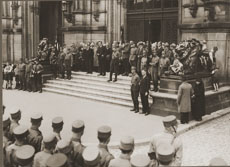


In 1933 the Law for the Restoration of the Professional Civil Service came into force, creating the instruments to remove non-Arians and other undesirables from office. At Hannover Institute of Technology only few cleansings are known, as hardly any non-Arians had been appointed.
On the initiative of the Institute of Technology, the only full professor to be dismissed was the Professor for Mechanics Otto Flachsbart, who was sent into retirement in June 1937 at the age of 39. His wife was of Jewish origin.
Some other teaching staff without the status of civil servants also had to leave, for example the Honorary Professor for Railway Bridge Construction Hugo Kulka, the Chemist and Privatdozent Günther Schiemann, the Associate Professor for Art History Alexander Dorner and the lecturer Richard Woldt, former Ministerialrat in the Prussian Department of Education.
Leibniz Universität is conducting a detailed review of this specific chapter in its history. In accordance with the moral and ethical objectives of its mission statement and its position in a democratic, constitutional state, Leibniz Universität Hannover is committed to a full and thorough investigation of the darkest chapter in its history in the years of National Socialist tyranny. Last year, two doctoral theses and a master’s thesis investigated the role of the university in the Nazi era. In May 2012, the Senate and Presidential Committee of Leibniz Universität passed the resolution to rehabilitate those persons whose academic titles had been withdrawn. In a second resolution, the Senate is to deal with the corresponding privileges awarded during this time.
Increasing Nazification of the Institute of Technology can be seen in the appointments made and the relationships of the scientists and academic teachers to the NSDAP and other Nazi organisations like the Nazi Association of German lecturers Nationalsozialistischer Deutscher Dozentenbund (NSDDB;). This reached a climax in the context of research relevant to the war effort. The issue of foreign or forced labour has not yet been fully addressed. Research is currently being carried out here.
In 1934 the Führerprinzip was introduced. The Rector and Deans were no longer elected, but nominated. The Rector acted as a trustee of the Minister. Student self-government was dissolved; a student body and a body of lecturers were created.
From the outbreak of war in 1939 lecturers and the majority of students were called up for military service or war work.








